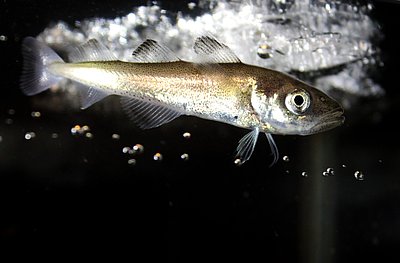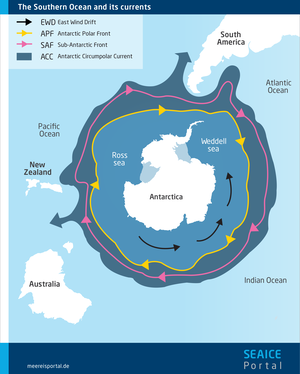Fishes
Compared to the Southern Ocean, few endemic species, i.e., species that live only in specific, spatially defined environments can be found in the Arctic Ocean. This is because the Antarctic is isolated by ocean currents and adjacent deep ocean areas, while the Arctic is more readily accessible to fish through connections to the Pacific and Atlantic Oceans. There are a variety of fish species in Arctic waters. Of these, there are only two that live very closely and directly with the sea ice year-round: the Arctic cod (Boreogadus saida) and Greenland cod (Arctogadus glacialis). Both are endemic to the Arctic Ocean (Christiansen et al., 2010). However, it goes without saying that all other fish species are also influenced by the presence and dynamics of the sea ice, and by the corresponding physical and ecological relationships.

Arctic cod (Boreogadus saida)
The Arctic cod (Boreogadus saida) is the most abundant fish in the Arctic and is closely associated with the sea ice. The Arctic cod lays its eggs in the depths of winter. The fish larvae hatch in spring, when the first ice algae blooms attract millions of small crustaceans. Many juvenile (young) Arctic cod, up to about 2 years of age, use the underside of the sea ice as a source of food and shelter from predators. Large populations can be found in the shelf seas of the Arctic. However, the Arctic cod is also quite active on the seafloor, where it searches for planktonic organisms to feed on. In the food web, it is thus an important link between the plankton and higher trophic levels such as marine mammals (seals and whales) and seabirds. This makes it a key ecological species in the Arctic Ocean. Examples of Arctic seabirds that feed on Arctic cod include guillemots and kittiwakes. Arctic cod can be found throughout the Arctic in populations of varying sizes, from small schools to massive swarms containing millions of fish. Arctic cod are quite flexible in terms of adapting to environmental changes and thus can live in a variety of habitats. However, just how important the sea-ice habitat actually is to the stability of the Arctic cod population is not yet fully understood (David et al., 2016). For example, along Arctic shelves, reports of Arctic cod living under the sea ice are common in autumn and winter. In addition, the species is known to travel long distances between its summer feeding grounds and winter spawning grounds, heading south in autumn and returning north in spring (Vestfals et al., 2019).
Greenland cod (Arctogadus glacialis)
Like the Arctic cod, the Greenland cod (Arctogadus glacialis) is an ice-associated fish species. It has a discontinuous circumpolar distribution, predominantly living off the Siberian coast, in the Chukchi Sea, in the Canadian Arctic and in the shelf areas of northeast Greenland. Rarely found in the European Arctic, its habitat consists in the fjords and shelf areas of the Arctic Ocean rather than the deeper and central Arctic Ocean (Aschan et al., 2009). Because of the wide distribution of Boreogadus saida in the Southern Ocean, the occurrence of Arctogadus glacialis is always accompanied by the occurrence of Boreogadus saida, but not vice versa. Because the two often coexist in the fjords and shelves of the Arctic Ocean, they also share the same food sources (Christiansen et al., 2012). Greenland cod are prey for e.g. ringed seals, narwhals and beluga whales.
The number and diversity of Antarctic fish fauna are less than one might expect, considering the age of the Antarctic marine ecosystem. There are roughly 300 Antarctic marine fish species described in 49 families, which represent only 1.3% of the world’s fish species (Barrera-Oro, 2002). Many of the fish species in the Southern Ocean can be found exclusively in this region (endemic species ). The fish fauna of the Southern Ocean above all include the Nototheniodei (Antarctic fishes), a suborder of the Perciformes, also known as perch-like fishes (Beers and Jayasundara, 2015). At the highest latitudes, the notothenioids (Antarctic fishes) account for 77% of species biodiversity, 92% of the abundance and 91% of the biomass (Eastman, 2005).
The Nototheniodei include several families, such as the cod icefishes (Nototheniidae), Antarctic plunderfishes (Harpagiferidae), the Artedidraconidae, Antarctic dragonfishes (Bathydraconidae), crocodile icefishes (Channichthyidae) and temperate icefishes (Bovichtidae). The Antarctic silverfish (Pleuragramma antarctica) is an open-water-zone fish of the Antarctic’s continental shelves, where it plays a key role in the food web and serves to connect the trophic levels. Adults are widespread in the coastal areas of the Antarctic, living in both open water and pack ice, and are usually found at depths of up to 900 m. In the Ross and Weddell Seas, the species accounts for over 90% of the local fish community, both in terms of numbers and biomass (Vacchi et al, 2012). Pleuragramma antarctica lays its eggs in early spring, in a unique habitat: the platelet ice of the Antarctic’s fast ice regions. The eggs mature amid the platelet ice, well protected from predators. The larvae hatch in spring, when extensive ice algae blooms appear, offering optimal food sources.
The Arctic polar cod and Antarctic silverfish, as the dominant fish species on the Arctic and Antarctic shelves, fulfil key ecological roles. Both are major food sources for seabirds, seals and whales in the polar seas. In order to thrive there, they have made important adaptations to the challenges posed by the ice-filled waters (Flores, 2017).
One important aspect is the ambient temperature: the colder it is, the more that metabolic processes are slowed, i.e., fish that have not adapted e.g. grow more slowly. Yet the Arctic polar cod and Antarctic silverfish use this slowing of metabolic processes, the result of local conditions, for their own advantage. The temperature affects the bodily fluids, making them more viscous; in turn, this makes it more difficult for the body to get enough oxygen and nutrients. In response, both species produce fewer red blood cells, which keeps their blood flowing freely. That’s beneficial, as oxygen solubility in blood serum increases at lower body temperatures (Flores, 2017).
These species’ bodily fluids have a freezing point slightly higher than that of seawater. As a result, ice crystals can form in their cells, which is potentially fatal. Accordingly, both species produce what are known as antifreeze glycoproteins (AFGPs), which consist of helical protein-sugar compounds and have the ability to bind to ice crystals, which inhibits recrystallisation. In addition, both the Arctic polar cod and Antarctic silverfish have perfectly adjusted their lifecycles to the temporal and spatial dynamics of the sea ice (Flores, 2017).
Aschan, M., O. V. Karamushko & I. Byrkjedal et al. (2009): Records of the gadoid fish Arctogadus glacialis (Peters, 1874) in the European Arctic. Polar Biol 32, pp. 963–970. https://doi.org/10.1007/s00300-009-0595-4
Barrera-Oro, E. (2002): The role of fish in the Antarctic marine food web: Differences between inshore and offshore waters in the southern Scotia Arc and west Antarctic Peninsula. Antarctic Science, 14(4), pp. 293-309. doi:10.1017/S0954102002000111
Beers, J. M. & N. Jayasundara (2015): Antarctic notothenioid fish: what are the future consequences of ‘losses’ and ‘gains’ acquired during long-term evolution at cold and stable temperatures? Journal of Experimental Biology, 218, pp. 1834-1845; doi: 10.1242/jeb.116129
Beers, J.M. & N. Jayasundara (2015): The Journal of Experimental Biology, p. 218, 1834-1845, doi:10.1242/jeb.116129
Christiansen, J.S., H. Hop & E. M. Nilssen et al. (2012): Trophic ecology of sympatric Arctic gadoids, Arctogadus glacialis (Peters, 1872) and Boreogadus saida (Lepechin, 1774), in NE Greenland. Polar Biol 35, pp. 1247–1257. https://doi.org/10.1007/s00300-012-1170-y
David, C., B. Lange & T. Krumpen et al. (2016): Under-ice distribution of polar cod Boreogadus saida in the central Arctic Ocean and their association with sea-ice habitat properties. Polar Biol 39, pp. 981–994 . https://doi.org/10.1007/s00300-015-1774-0
Eastman, J.T. (2005): The nature of the diversity of Antarctic fishes. Polar Biol 28, pp. 93–107. https://doi.org/10.1007/s00300-004-0667-4
Flores, H. (2017): Der arktische Polardorsch und der Antarktische Silberfisch: Erfolgsgeschichten im Eismeer. In: Hempel G., K. Bischof & W. Hagen (eds.), Faszination Meeresforschung. Springer, Berlin, Heidelberg, pp. 159-162
Vacchi, M., A. L. DeVries, & C. W. Evans et al. (2012): A nursery area for the Antarctic silverfish Pleuragramma antarcticum at Terra Nova Bay (Ross Sea): first estimate of distribution and abundance of eggs and larvae under the seasonal sea-ice. Polar Biol 35, pp. 1573–1585. https://doi.org/10.1007/s00300-012-1199-y
Vestfals, C.D., F. J. Mueter & J. T. Duffy-Anderson et al. (2019): Spatio-temporal distribution of polar cod (Boreogadus saida) and saffron cod (Eleginus gracilis) early life stages in the Pacific Arctic. Polar Biol 42, pp. 969–990. doi.org/10.1007/s00300-019-02494-4

